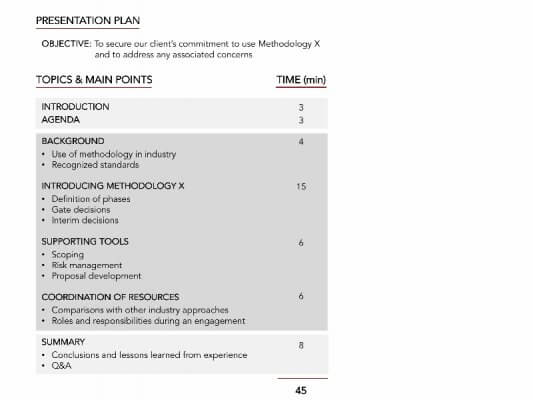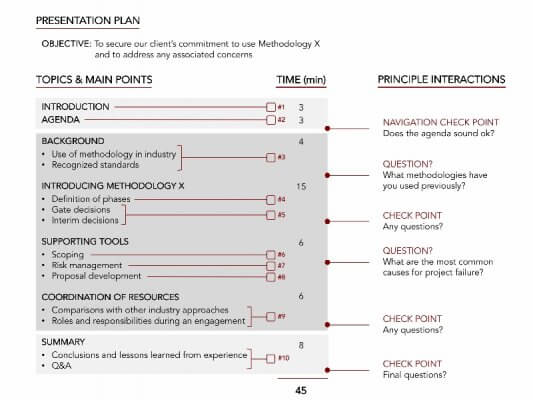Brilliant business presentations and pitches don't happen by chance; here's how you can prepare to wow your audience.
Business Critical Presentations: The Definitive Guide
Brilliant business presentations and pitches don't happen by chance; here's how you can prepare to wow your audience.

Presentations are among the most commonly used communication vehicles in business today yet can vary considerably in their effectiveness.
At SPConsulting we develop presentations for clients on daily basis to support major and often mission critical business initiatives. They need to be successful as failure comes at a high price.
This article shares a set of well-proven guidelines to help ensure that your next presentation hits the required target. We use these guidelines ourselves in the consulting industry but they could be applied in a wide range of other business contexts.
We will demonstrate that presentation design starts with a strategic thinking exercise, examine the formulation of a clear presentation plan and discuss how it can be translated into a set of strong presentation slides that support the speaker, yet embody sufficient flexibility.
Seven relatively simple steps will be considered each with accompanying guidelines based upon logic, not rocket science:
1. Set a well-articulated objective
2. Define the topics and main discussion points
3. Plan an audience interaction approach
4. Create the slide deck
5. Craft an interesting narrative
6. Decide how questions will be handled
7. Be prepared to adapt on the fly
The final result: an approach that is easy to implement for any presenter willing to invest sufficient effort to secure success.
1. Set a well-articulated objective
It may sound basic, but this is where we’ve found the design of many presentations to break down. Think about the real objective of your presentation.
A colleague once explained that the objective of his presentation was ‘to inform a client about a methodology that he planned to use on an upcoming project’. Is that a good presentation objective? Actually not.
When presenting we should avoid talking for the sake of talking. The objective of a presentation is therefore rarely purely to inform. Consider the reasons for sharing the information in the first place. After some discussion the colleague re-framed his objective:
‘To secure our client’s commitment towards the use of the suggested methodology and to address any associated concerns.'
The design of an effective presentation needs to be objective-oriented. Make sure that the objective that you define is the one that you want to achieve.
2. Define the topics and main discussion points
Ask yourself the question, ‘Which topics need to be covered well to achieve the objective?’ Be selective in your choice. A crisp presentation is focused and avoids inclusion of material that is only partially relevant.
Consider the importance of each topic and allocate a time budget to each allowing for the fact that additional time is likely to be consumed by questions and discussions. Then within each topic select the main discussion points to be covered within the time allowed.

Fig 1: A presentation plan based upon topics, timing and main discussion points
3. Plan an audience interaction approach
Many presentations rely upon a dialogue with the receiving audience for their objective to be achieved. Whilst some of this interaction can be ad-hoc the principle interactions where inputs or agreements are needed should be planned in advance.
A good practice is to make your first interaction early. It gives a signal to the audience that a two-way dialogue is expected and they are less likely to sit back and switch into listening-mode.
Interactions can take many forms: Check points, open questions, asking for a show of hands, and syndicate group discussions are just a few examples. Be creative, but not over creative. Select the interaction methods that will best achieve the desired reaction.

Fig 2: a presentation plan indicating content distribution
4. Create the slide deck
Now we are in a position to start creating the slide deck. This will require two design decisions: One regarding the distribution of content onto presentation slides, the second selecting the optimal design approach for each.
When distributing content good judgement is required. Not every discussion point is likely to require a slide of its own, whereas some may need to be illustrated using multiple slides.
Many presentations fall into the trap of becoming slide heavy making them clumsy to deliver and tiring for the audience to absorb. If you don’t plan to talk over a slide for at least a few minutes, is it needed?

Fig 3: a presentation plan indicating content distribution
5. Craft an interesting narrative
The power of a compelling presentation lies in the narrative and the impact made by the speaker, not the slideware. This deserves a lot of thought. Ensure that your message is powerful and concise.
Identify relevant examples and anecdotes to support key points and make sure that they will connect well with your audience. Consider your intended delivery style: Serious, relaxed, emphatic or somewhat humorous? Make sure that the tone fits the topic, and of course your own personality as a speaker.
6. Decide how questions will be handled
Handling questions is an art. The ability to handle questions smoothly shows that you are knowledgeable and well prepared. Anticipate the most likely questions in advance and consider your responses.
At the same time keep in mind that when a question is asked the speaker has a choice: either to answer the question directly; to defer the question politely to a later point in the presentation, or take the question off-line if the answer is specific and unlikely to be of interest to others.
Another option is to use your audience. Ask others in the room to propose answers and facilitate a constructive discussion.
7. Be prepared to adapt on the fly
The logical way to present your material would be sequentially, from start to finish however the real world is not always that simple. When presenting to a group of senior executives you may find that their interest lies in some topics but not in others.
Telling people what they know already is an engagement killer, so you might need to depart from your plan.
An important action is the navigation check point taken after the agenda. The feedback collected here will help you decide how to navigate onwards. Be flexible. You may need to shorten the time spent on certain topics simply emphasizing the must-know information, or to skip some topics completely if they turn out to be redundant.
In summary, strong presentation delivery is a dynamic exercise based upon an objective-driven framework of well-structured content. The seven simple steps discussed have been proven to create robust presentations, yet still embody sufficient flexibility.
Less successful presentations can usually trace their shortfalls back to one of more of these steps. Accompanied by the attractive design of material and good platform technique their use can be very powerful.
Good luck with your next business critical presentation! Share this article if you found it useful, and feel free to send in your own presentation design experiences.
Samir Parikh is the CEO of SPConsulting AB, an organisation specialised in the development of consultative capabilities.
Thanks for signing up to Minutehack alerts.
Brilliant editorials heading your way soon.
Okay, Thanks!

